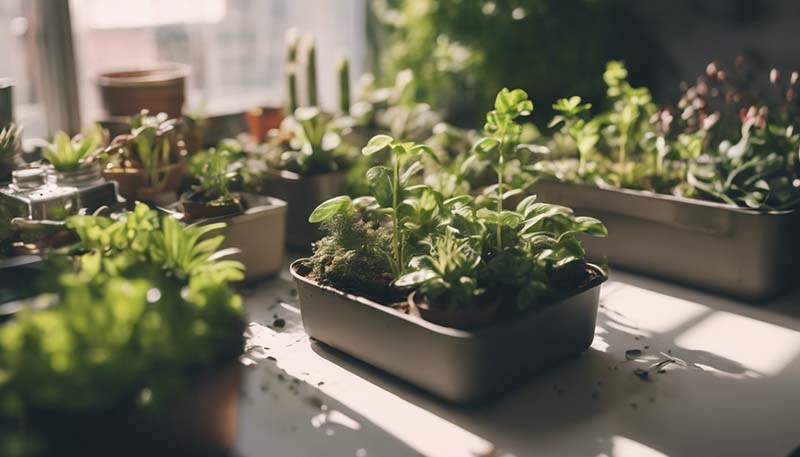The Role of Indoor Gardening in Urban Sustainability
Urban sustainability is a growing concern in the 21st century as cities continue to expand and populations become more concentrated in urban areas. One of the many facets of urban sustainability is the integration of green spaces and sustainable practices into the urban fabric. Indoor gardening is a practice that can play a significant role in promoting urban sustainability, enhancing the quality of life for city dwellers, and contributing to the overall health of the environment. This article explores the various ways in which indoor gardening can contribute to urban sustainability.
1. Reducing Urban Heat Islands
Urban heat islands (UHIs) are a phenomenon where urban areas experience higher temperatures than their rural surroundings. This is due to the concentration of heat-absorbing surfaces such as roads, buildings, and other infrastructure. Indoor gardening can help mitigate the effects of UHIs by increasing the amount of vegetation within buildings. Plants absorb heat and release it through a process called transpiration, which can help cool indoor spaces and reduce the need for air conditioning.
Advertisement
2. Improving Air Quality
Plants are natural air purifiers. They absorb carbon dioxide and release oxygen, improving the air quality within indoor spaces. Indoor gardening can significantly enhance the air quality in urban environments where outdoor air pollution may be high. Additionally, plants can also absorb volatile organic compounds (VOCs) and other harmful substances, contributing to a healthier living environment.
3. Promoting Biodiversity
Biodiversity is crucial for the health of ecosystems, and urban environments often lack the variety of plant and animal species found in rural areas. Indoor gardening can help promote biodiversity by providing habitats for various species, including insects and birds. This can also contribute to the overall health of the city's ecosystem by supporting pollinators and other beneficial organisms.
4. Reducing Food Miles
Food miles refer to the distance that food travels from the point of production to the point of consumption. The longer the distance, the greater the environmental impact in terms of carbon emissions and resource use. Indoor gardening, especially in the form of urban agriculture, can help reduce food miles by enabling residents to grow their own food. This not only reduces the environmental impact but also supports local economies and fosters a sense of community.
5. Enhancing Mental Well-being
The benefits of indoor gardening extend beyond the physical environment to the mental well-being of urban residents. Studies have shown that interaction with plants and gardening activities can reduce stress, improve mood, and contribute to a sense of accomplishment and satisfaction. In a high-stress urban environment, access to green spaces and gardening opportunities can be a valuable tool for promoting mental health and well-being.

6. Water Conservation
Indoor gardens can be designed to be water-efficient, using techniques such as drip irrigation and rainwater harvesting. By managing water resources effectively, indoor gardening can contribute to water conservation efforts in urban areas, where water scarcity can be a significant issue.
7. Education and Awareness
Indoor gardening can serve as an educational tool, raising awareness about the importance of sustainable living and environmental stewardship. Schools, community centers, and other public spaces can incorporate indoor gardens into their programs, providing opportunities for hands-on learning and engagement with sustainable practices.
8. Aesthetic and Recreational Value
Beyond their environmental benefits, indoor gardens offer aesthetic and recreational value. They can transform otherwise utilitarian spaces into vibrant, living spaces that provide a sense of tranquility and connection to nature. This can be particularly important in urban environments where access to green spaces may be limited.
9. Economic Benefits
Indoor gardening can also have economic benefits. It can create job opportunities in the form of urban agriculture, plant nurseries, and related industries. Additionally, homegrown produce can reduce the cost of groceries for urban residents, contributing to financial sustainability at the household level.
10. Fostering Community
Finally, indoor gardening can foster a sense of community among urban residents. Shared gardening spaces can provide a social hub where people can connect, collaborate, and learn from one another. This can help to build social capital and strengthen community bonds in an often fragmented urban environment.
In conclusion, indoor gardening is a multifaceted practice that can significantly contribute to urban sustainability. By reducing urban heat islands, improving air quality, promoting biodiversity, reducing food miles, and enhancing mental well-being, indoor gardens can help to create healthier, more sustainable, and more connected urban communities. As cities continue to grow and evolve, the role of indoor gardening in promoting sustainability will only become more critical.
Comment